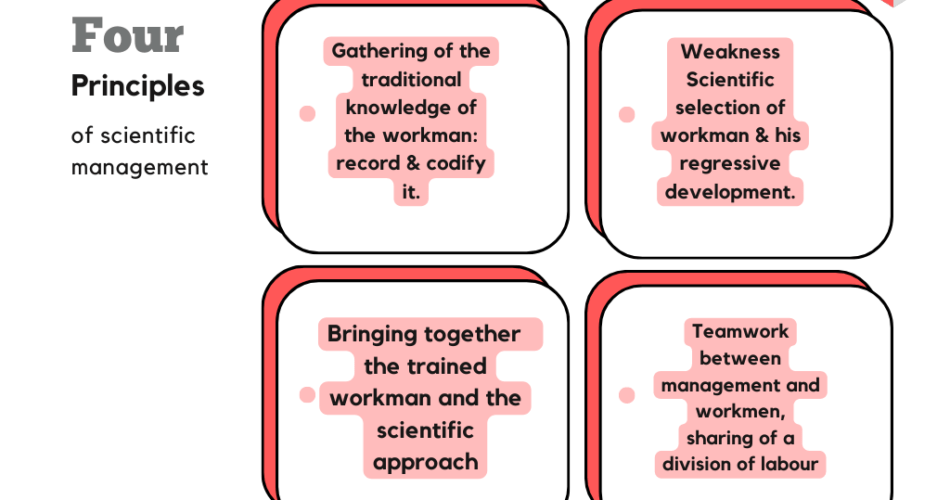Principles of Scientific Management
In his book Principles of Scientific Management, Taylor gave the following principles such as –
- The development of a true science of work
- The scientific selection and progressive development of the workman
- Equal division of work between management and workers
- Mutual collaboration of the workers and management
The detailed explanation of the above four principles of scientific mangement as explained by the Henry Fayol in his book (The Principles of Scientific Mangement) are as follows –
1. The Development of a True Science of Work
This needs a scientific investigation of a ‘large daily task’ to be done by qualified workers under optimum conditions. This can be done by gathering traditional knowledge of the workers which is his lifelong fixed capital and a most valuable property.
The results of investigation have to be classified, tabulated, and reduced into rules and laws to find out the ideal working methods or what is called ‘one best way of doing job. Such development of science of work enables the organization to produce more; enables the worker to receive higher wages and a much larger profit to the company.
2. The Scientific Selection and Progressive Development of the Workman
To ensure the effective performance of the scientifically developed work, there is also need to select the worker scientifically possessing physical and intellectual qualities. This needs a deliberate study of the aptitude, nature and performance of the worker and finding out what possibilities and limitations one has for future development.
Taylor believed that every worker has potentialities for development. He insisted that every worker must be systematically and thoroughly trained. Taylor felt that it is the responsibility of the management to develop the worker offering him opportunities for advancement to do the job to the fullest realisation of his natural capacities. It is necessary to ensure that the employees accept the new methods, tools and conditions willingly and enthusiastically. (Sapre 1970: 14)
3. Equal Division of Work between Management and Workers
Taylor’s third principle was an open advocacy of an equal division of work and responsibility between management and workers. Taylor had noted in his observations the unhealthy trend of the managers to place increasing burden on the workers, while assuming for themselves only minimum responsibilities.
In this context Taylor advised that half of the workers work should be taken over by the management. The management should undertake the functions for which it was best suited, i.e., planning, organizing, controlling and determining the methods of work.
4. Mutual Collaboration of the Workers and Management
The last Taylorian principle was that there should be active cooperation and cordial relations between management and workers. There should be mutual faith and trust. Efficiency and productivity can be best promoted by creating a healthy and congenial environment in the organization which is the joint responsibility of both workers and the management.

Taylor is careful to assert that scientific management is no new set of theories that have been untried, a common misunderstanding. He says that the process of scientific management has been an evolution, and in each case the practice has preceded the theory.
Further, scientific management is in practice in various industries: “Almost every type of industry in this country has scientific management working successfully.” (Shafritz: 2008. p.69)
By maximizing the productive efficiency of each worker, scientific management would also maximize the earnings of workers and employers. Hence, all conflict between capital and labour would be resolved by the findings of science. (Bendix1956: 274-75)
However, none of these principles could be isolated and called scientific management. It is a combination of all elements described above.
Summary of Combined Elements of the Principles of Scientific Mangement
It is no single element or principles, but rather this whole combination, that constitutes scientific management, which may be summarised as:
- Science, not rule of thumb: Taylor pioneered the introduction of the method of scientific inquiry into management practice. He suggested that by following the rules of the thumb, all would not be equally effective. He believed that there was only one best method to maximise efficiency. Even a small production work can be scientifically planned and managed.
- Harmony, not discord: managers serve as a link between owner and the workers. There should be a complete harmony between management. and workers. Both should realise that both are important. Taylor had called for complete revolution on the part of both management and workers. It means that management and workers should transform their thinking.
- Cooperation, not individualism: this principle is the extension of the second principle. Competition must be replaced by cooperation. Both should realize they need each other. Workers should be rewarded for their performance. According to Taylor, there should be almost equal division of work and responsibility between workers and management based on their expertise, skills, information..
- Maximum output, in place of restricted output: The principle talk about that both management and worker should work collectively an efficiently for the maximum output, not for the restricted number. Maximum output will generate not only benefits for the company rather incentives for the workers too.
- The development of each man to his greatest efficiency and prosperity: Industrial efficiency depends on individual competencies. Workers training was essential to develop workers. Taylor was of the view that the concern of efficiency could be built in right in the process of employee selection.

